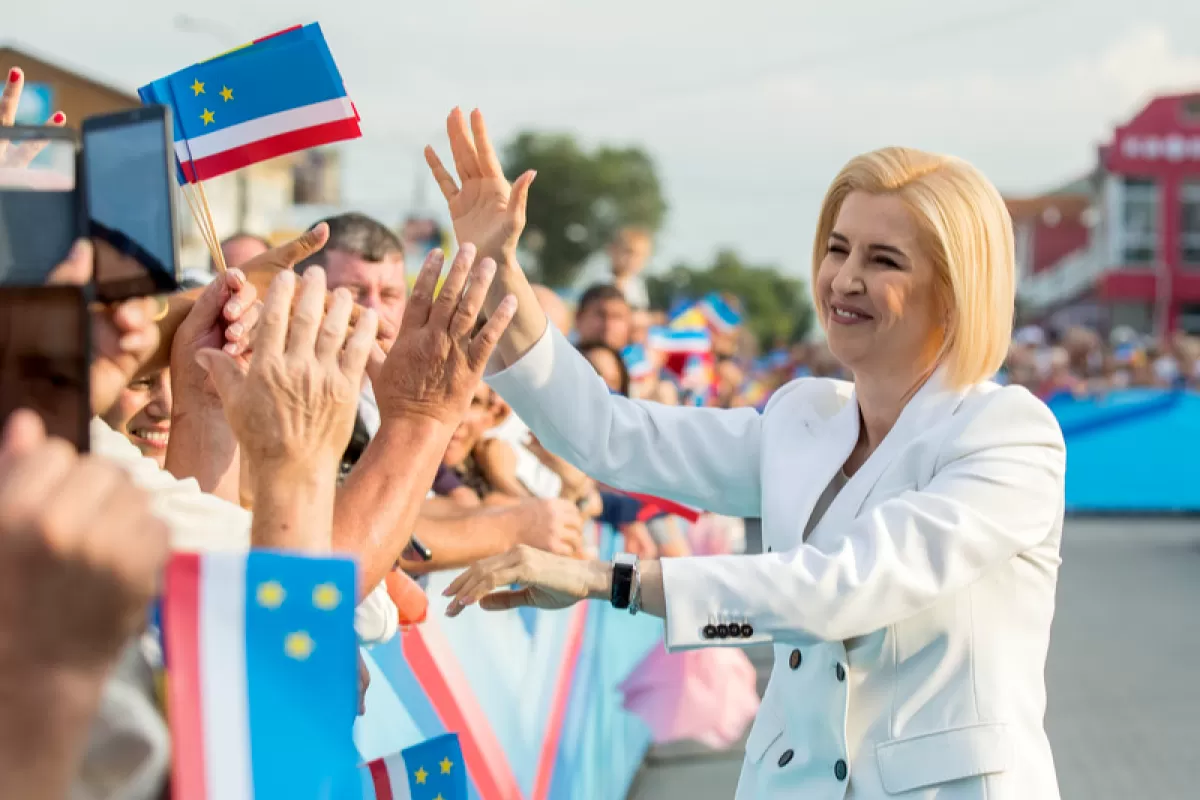
Găgăuzia is perhaps the most pro-Russian region in the Republic of Moldova. A breakaway region since the early 90s, Găgăuzia eventually recognized Chișinău’s sovereignty, although it wants to break with this country in the event of a unification with Romania or even EU accession.
From “republic” to autonomous region with “historical rights to self-determination”
On August 19, the Autonomous Territorial Unit of Găgăuzia (ATUG) in southern Moldova marked 32 years since the proclamation of the Republic of Găgăuzia. The entity that surfaced before the Republic of Moldova was ever proclaimed a sovereign state, remained a de facto separatist unit for more than four years.
The Găgăuz are a Turkic people who settled in Dobruja in the 13th century, embracing Orthodox Christianity. In the 13th century, the Russian Empire provided the Găgăuz with the opportunity of relocating to southern Bessarabia, a province it had annexed in 1812, more specifically in the region called Bugeac, inhabited by a tribe of Nogais. Official historiography places the first Găgăuz state entity around the 13th century. The first Republic – the Comrat Republic – was founded during the 1907 Russian Revolution. Still, the republic wouldn’t’ last more than a few days, and the Găgăuz seemed to adapt smoothly to communism and the Soviet period. Although their native tongue was Turkish, they adopted Russian as the main language of communication.
The Găgăuz people started demanding their autonomy and later their independence at the end of the 1980s, with the advent of the national liberation movement in the Moldovan Soviet Socialist Republic (MSSR), against the backdrop of the collapse of the USSR. One of the reasons behind their claims was “the threat of Romanianization” and the “whip of the Romanian gendarme”, which echoed the same themes spread by Russian speakers on the left-hand side of the Dniester back then. On November 12, 1989, a Găgăuz Council proclaimed the creation of the Găgăuz Autonomous Soviet Socialist Republic at the level of the MSSR, just as Chișinău was seeing the first open protests against the Soviet regime, such as the boycott of the Bolshevik Revolution anniversary on November 7. On August 19, 1990, just two weeks before Transnistria proclaimed its independence, the Republic of Găgăuzia was created, an entity that would de facto endure until 1995.
Formal relations between Chișinău and Comrat were established no earlier than 1994, after the “Agrarian”-dominated Parliament (a center-left party, made up mostly of former Soviet apparatchiks) adopted the controversial Constitution that recognized the “Moldovan language” and introduced the status of permanent neutrality. Parliament went on to adopt a law “on the special judicial status of Găgăuzia (Găgăuz-Yeri). This status stipulated, among other things, that Găgăuzia had its own Parliament and Government, and was ruled by a Bashkan or governor, who was by default a member of the Moldovan Government. Additionally, “in the event of any change in the status of the Republic of Moldova as an independent state, the people of Găgăuzia have a right to international self-determination.” This provision first and foremost referred to the “risk” of the Republic of Moldova uniting with Romania, although some pundits believe the provision might be equally invoked in the case of Moldova’s EU accession. The People’s Assembly criticized, for instance, the EU’s decision to grant Moldova EU candidate status.
In 2003, during the communist regime in Chișinău, Găgăuzia’s status of territorial administrative unit was also enshrined in the Constitution. Besides, the People’s Assembly in Comrat was also bestowed the right to pass legislation.
Comrat’s misgivings about the EU and Romania, despite their investments in Găgăuzia
Despite having secured all these rights, the separatist movements in Găgăuzia continued to militate for greater autonomy, endorsed by various local leaders. On February 2, 2014, shortly after the Republic of Moldova had ratified the EU Association Agreement, and the Euromaidan protests were in full swing in Ukraine after president Yanukovych’s refusal to sign Ukraine’s own EU association agreement, Găgăuzia hosted a referendum that was outlawed by Moldovan authorities. Funded from obscure sources, the referendum resulted in 99% of voters opting in favor of Moldova joining the Eurasian Union and the same percentage of votes opposing European integration. Moreover, 99% of voters wanted Găgăuzia to become independent in case the Republic of Moldova disappeared as a state.
The political options of the people of Găgăuzia have always favored pro-Russian parties and politicians. For instance, in the second round of the presidential election of 2016, 98,89% of people voted in favor of the then Socialist leader, Igor Dodon, to the detriment of Maia Sandu.
Over the years, the European Union has financed dozens of projects in Găgăuzia. Romania has done the same, the best-known project being Romania’s assistance for refurbishing Moldova’s kindergartens. By 2018, Romania had invested 26 million EUR in the said project, and Găgăuzia was one of the biggest beneficiaries.
Nevertheless, according to a survey carried out in 2021 by the Institute for Public Policies, 40% of Găgăuz people believed the Republic of Moldova is getting more external assistance from Russia, and only 14% believed the assistance was coming from the EU. This survey conducted on the territory of Găgăuzia and in the Taraclia rayon, which has a majority Bulgarian population, reveals that a third of Găgăuz identify their cultural heritage to be Găgăuz, 30% Russian and only 12.6% Moldovan. Approximately 90% of interviewees turned to Russian sources of information, while most respondents confided in the Russian state media.
Things have apparently started to change to a certain extent, albeit at a very slow pace. According to the aforementioned survey, compared to the findings of a similar sociological study carried out in 2015, the number of Găgăuz who want the Republic of Moldova to become part of the Russian Federation went down by half, from 34% to 17%. Admittedly, the number of respondents who opted in favor of restoring the USSR went up from 4% to 13.5%. In addition, in the course of a decade, the number of respondents who recognize the “Moldovan language” doubled, but even so the percentage accounts for a little less than a quarter of total interviewees. On August 31, 2021, which marks the Romanian Language Day, the current Bashkan of Găgăuzia, Irina Vlah, posted the first message in the history of ATUG where a Comrat official doesn’t use the term “Moldovan language”. “Today, we are celebrating the Romanian Language Day – it is a major celebration for all the citizens of the Republic of Moldova”, Vlah wrote, her message sparking criticism in Comrat. Worth noting, however, is that Vlah has reached the end of her second (and last) term in office. Before joining Igor Dodon’s Socialist camp, she had been a member of the communist party. Vlah appears to have developed good relations with Romania’s former ambassador to the Republic of Moldova, Daniel Ioniță, who paid a number of visits to Găgăuzia. Besides, in recent years, one of the most important Romanian projects was launched in Găgăuzia – erecting a new building for the only high-school with Romanian-language teaching in Comrat. Vlah also has a blog, with a Romanian-language version, which is again something unheard of for a Găgăuz official, all the more so as Vlah supported closer relations with Russia in election campaigns and often appeared in public alongside Vladimir Putin. It is very likely Irina Vlah might have a personal stake in implementing infrastructure projects. This might also be linked to her future political aspirations, given that at the end of last year Vlah didn’t rule out a possible candidacy in the Moldovan presidential election.
Irina Vlah’s actions are nonetheless at odds with the previous position of Găgăuz authorities. For instance, in 2013, Găgăuzia renamed the school subjects “the Romanian Language and Literature” and “the History of Romanians” as “the Moldovan Language and Literature” and “the History of Moldova”.
Moscow’s Trojan horse in the Republic of Moldova
Given the huge ideological gap between the majority population of the Republic of Moldova and the people of Găgăuzia, it seems that one of the factors that prevented things from escalating in Găgăuzia is the lack of unity among the local elites. Although the over 120,000 inhabitants of ATUG virtually share the same vision in terms of internal and external policy-making, domestic disputes are sometimes very harsh, often resulting in rows, conflicts and even physical clashes between politicians. Apart from the numerous national elections in the Republic of Moldova, Găgăuzia hosts two types of additional elections: elections for the People’s Assembly and for the position of Bashkan, where competition is fierce. The election law and the specific local traditions favor independent candidates in the elections, therefore the People’s Assembly, made up of 35 deputies, is a motley gathering of people of various backgrounds. For instance, after the recent election for the People’s Assembly held in September-October 2021, its president was elected only in February 2022, after the 15th round of voting, with the minimum number of votes required, 18. The last round of elections for the office of Bashkan, held in 2019, provoked a huge public scandal, after the majority of candidates urged voters to boycott the elections. The voter turnout was close to the minimum threshold, and the opposition invoked serious election fraud.
Russia’s military aggression in Ukraine, as well as the consequences of the war for the Republic of Moldova, have inflamed passions in Comrat. Several deputies of the People’s Assembly openly supported the Russian invasion by means of posts and messages on social media. They deliberately displayed the ribbon of Saint George, although the Parliament in Chișinău had specifically banned its public display as a symbol of military aggression. In recent months, several anti-government rallies have been staged in Găgăuzia. In addition to messages protesting soaring inflation and the price hikes, people also voiced separatist slogans. In early August, a protest held in Ceadîr-Lunga raised the question of Găgăuzia’s separation from Moldova and its annexation to the Russian Federation. “When will the Russian they call Vladimir Vladimirovich come to claim our Russian lands? This land was Russia’s to being with. Putin will come one day, and we will greet him with flowers”, regional activist Dmitry Zirov was quoted by nokta.md.
One of the leaders of the separatist movements in the 90s, Mikhail Kendighelean, announced the organization of a meeting of regional leaders who will call on Russia and Turkey to defend Găgăuzia against Romania.
Therefore, despite changes occurring in Moldovan society, Găgăuzia and the Găgăuz remain deeply rooted in Russian politics and the Russian world. Considering the Republic of Moldova has to deal with another separatist region in the east and other Russian-speaking minorities on its territory, Găgăuzia is yet another Achilles' heel, or rather a Trojan horse.


